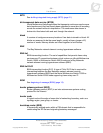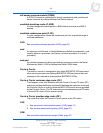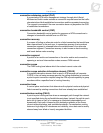
- 28 -
List of terms
Nortel Multiservice Switch 7400/15000/20000
Terminology
NN10600-005 7.2S1 Standard
PCR7.2 and up March 2006
Copyright © 2006, Nortel Nortel Confidential
CIDR
See classless inter-domain routing (CIDR) (page 28).
CIR
See committed information rate (CIR) (page 30).
circuit emulation service (CES)
A service that converts and transports data from one circuit format to another.
For example, a CES can convert DS1 circuit data to ATM cells at the ingress
node for transport over an ATM network, and then reconvert the data to its
original DS1 circuit format at the egress node.
Class A, B, and C (internetworking)
Address ranges for Internet addressing. These ranges are based on the first
eight bits of the address. Each range allows less of the whole address for host
addresses than the previous range.
• A Range from 1 to 126. This class is used for networks that have up to 2
24
nodes, such as government agencies and major university systems.
Default address mask of 255.0.0.0.
• B Range from 128 to 191. This class is used for networks that have up to
2
16
nodes, such as large corporations. Default address mask of
255.255.0.0.
• C Range from 192 to 254. This class is used for smaller networks that
have fewer than 255 nodes, such as smaller colleges and businesses.
Default address mask of 255.255.255.0.
class of service (IP CoS)
A Nortel Multiservice Switch IP differentiated service feature that provides
limited IP traffic management.
classless inter-domain routing (CIDR)
An internetworking protocol that uses subnetwork masks other than the
defaults used for IP address classes. Defined in RFC1517 and RFC1518.
clock master
The bus tap in slot 0 or 15 that supplies clock signals for a backplane bus. This
term can also be used for the processor card that contains this bus tap.
closed user group (CUG)
A collection of users whose members are governed by certain rules of access
with respect to communication with each other, with members of other closed
user groups, and with the open part of the network. These rules maintain
security, prohibit unauthorized access. and provide logical partitioning of the
network for better access control.


















